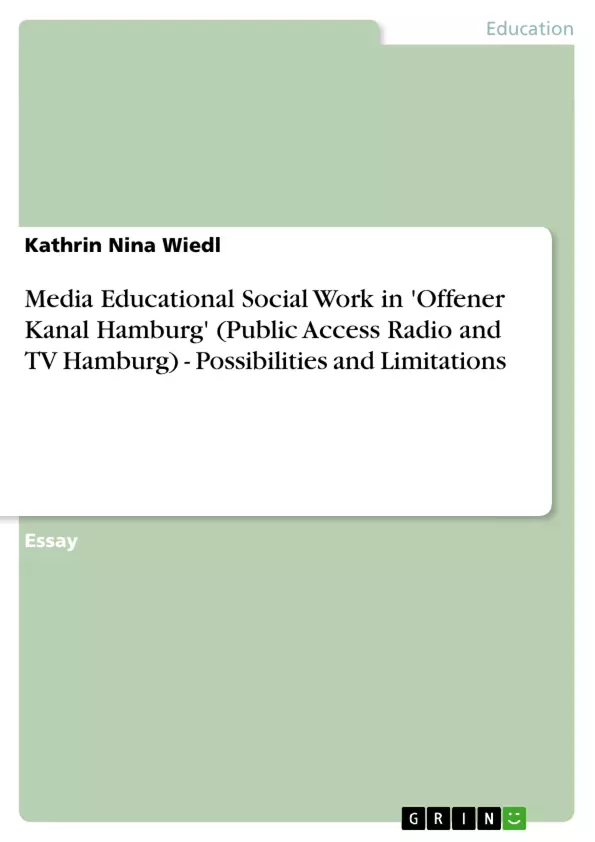This article will discuss if, and to what extent, media educational social work is practiced in the German public access television channel “Offener Kanal Hamburg.” “Offener Kanal Hamburg” is producing and broadcasting programs made by non-professional local residents, many of them socially marginalized groups, like migrants or old people; but also children and teenagers are supported in their 'first steps' as TV-producers. These groups are trained and supported by permanently employed editors. I will begin by describing the role of “Offener Kanal” for media educational work in general. Then I will give a more precise definition of media educational social work – as a part of social work. I will conclude by determining whether the work of public access channels can be described as media educational social work and I will show the role that institutions like the “Offener Kanal” play for cooperative projects in the area of media educational social work.
Inhaltsverzeichnis (Table of Contents)
- INTRODUCTION
- "OFFENER KANAL" AND MEDIA EDUCATION
- "Offener Kanal"
- Media Education in "Offener Kanal"
- MEDIA EDUCATIONAL SOCIAL WORK
- Introduction
- What Distinguishes Social Work?
- Media Educational Social Work
- Three Fundamental Target Areas of Media Educational Social Work
- Encouraging Participation
- Educational Learning Aspect
- Promotion of Communicative Competence and Authentic Experience
- CONCLUSION
- REFERENCES
Zielsetzung und Themenschwerpunkte (Objectives and Key Themes)
This article investigates the presence and extent of media educational social work within "Offener Kanal Hamburg," a public access television channel. The article examines the role of "Offener Kanal" in media education, providing a detailed definition of media educational social work. It then explores the applicability of this concept to public access channels and analyzes the role of "Offener Kanal" in collaborative media educational social work projects.
- Media Educational Social Work in Public Access Television
- The Role of "Offener Kanal" in Media Education
- Collaborative Projects in Media Educational Social Work
- The Importance of Counter-Publicity
- Communicative Competence and Authentic Experience
Zusammenfassung der Kapitel (Chapter Summaries)
Introduction: This section introduces the topic of media educational social work in the context of "Offener Kanal Hamburg." It outlines the article's objectives, which include exploring the role of "Offener Kanal" in media education and examining whether its activities can be classified as media educational social work.
"Offener Kanal" and Media Education: This chapter provides a detailed description of "Offener Kanal," a public access radio and television station in Hamburg. It highlights the station's unique features, including its commitment to free access, lack of censorship, and technical and journalistic support for program makers.
Media Educational Social Work: This section defines media educational social work as a distinct practice within social work. It examines the core values and principles that differentiate social work from other disciplines, emphasizing the importance of empowering individuals and communities. The chapter then outlines the specific characteristics of media educational social work, including its focus on media literacy, critical thinking, and fostering communicative competence.
Three Fundamental Target Areas of Media Educational Social Work: This chapter explores three key areas of focus for media educational social work. It delves into the importance of encouraging participation, promoting educational learning, and facilitating the development of communicative competence and authentic experience. This section provides a detailed overview of the specific strategies and approaches utilized in each of these areas.
Schlüsselwörter (Keywords)
The main focus of this article lies on media educational social work, public access television, "Offener Kanal Hamburg," communicative competence, counter-publicity, and the role of media in shaping public opinion and promoting participation.
- Arbeit zitieren
- Dipl. Paed. Kathrin Nina Wiedl (Autor:in), 2003, Media Educational Social Work in 'Offener Kanal Hamburg' (Public Access Radio and TV Hamburg) - Possibilities and Limitations, München, GRIN Verlag, https://www.grin.com/document/36778



